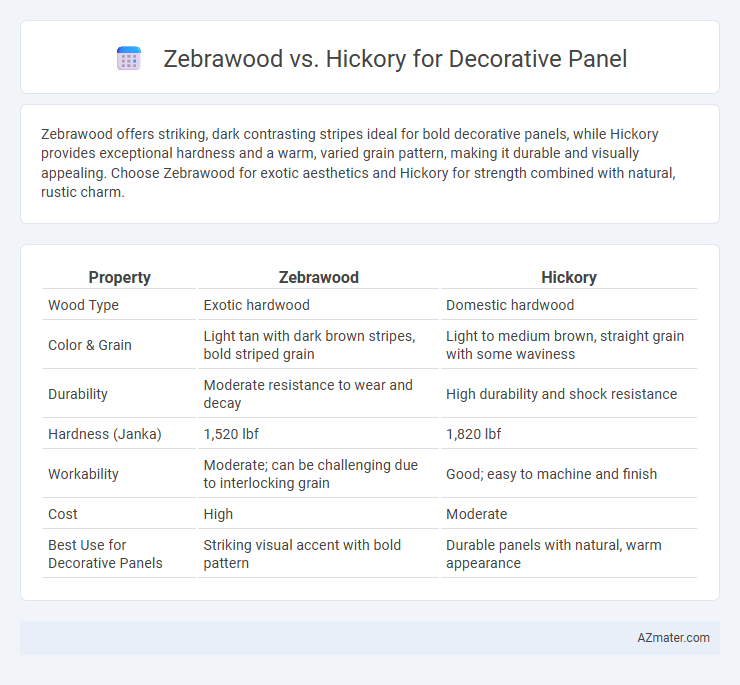Zebrawood offers striking, dark contrasting stripes ideal for bold decorative panels, while Hickory provides exceptional hardness and a warm, varied grain pattern, making it durable and visually appealing. Choose Zebrawood for exotic aesthetics and Hickory for strength combined with natural, rustic charm.
Table of Comparison
| Property | Zebrawood | Hickory |
|---|---|---|
| Wood Type | Exotic hardwood | Domestic hardwood |
| Color & Grain | Light tan with dark brown stripes, bold striped grain | Light to medium brown, straight grain with some waviness |
| Durability | Moderate resistance to wear and decay | High durability and shock resistance |
| Hardness (Janka) | 1,520 lbf | 1,820 lbf |
| Workability | Moderate; can be challenging due to interlocking grain | Good; easy to machine and finish |
| Cost | High | Moderate |
| Best Use for Decorative Panels | Striking visual accent with bold pattern | Durable panels with natural, warm appearance |
Introduction to Zebrawood and Hickory
Zebrawood, known for its striking dark stripes on a creamy tan background, offers a bold, exotic look ideal for decorative panels requiring high visual impact. Hickory features exceptional hardness and a warm, variegated grain pattern ranging from creamy white to reddish brown, providing durability and a classic appearance. Both woods deliver distinctive aesthetics and robust performance, with Zebrawood favored for vibrant patterns and Hickory prized for structural strength in panel applications.
Origin and Availability
Zebrawood originates primarily from West Africa, particularly Gabon and Cameroon, and is known for its distinctive dark stripes on a light background, making it a rare and exotic choice for decorative panels. Hickory is native to North America, especially the United States, renowned for its durability and abundant availability, which ensures consistent supply and cost-effectiveness for large-scale projects. The limited availability of Zebrawood often results in higher prices and longer lead times compared to the widely accessible Hickory.
Aesthetic Differences
Zebrawood features bold, contrasting dark stripes on a pale golden background, creating a striking, exotic look ideal for decorative panels seeking a dramatic visual impact. Hickory displays a more subtle, uniform grain with warm, reddish-brown tones and occasional knots, offering a rustic, natural aesthetic that blends well with traditional or casual interior designs. The distinct grain patterns and color contrasts define each wood's unique visual appeal, making Zebrawood suited for modern, eye-catching applications, while Hickory favors warmth and texture.
Grain Patterns and Color Variations
Zebrawood features striking, dark brown and black stripes on a pale golden-yellow background, creating a bold, exotic grain pattern ideal for eye-catching decorative panels. Hickory presents a more varied grain with tight, straight lines and occasional curls, ranging from creamy white to reddish-brown hues, offering a warm, rustic aesthetic. The distinct grain contrast and unique color variations of Zebrawood provide a dramatic look, while Hickory's natural tones contribute to a more traditional, cozy ambiance.
Durability and Hardness Comparison
Zebrawood exhibits a Janka hardness rating of approximately 1,850 lbf, making it moderately durable but more prone to surface scratches compared to Hickory, which boasts a higher Janka hardness of about 1,820 to 1,930 lbf, known for its exceptional toughness and resistance to wear. Both woods offer strong durability, but Hickory's dense grain structure provides superior impact resistance, ideal for high-traffic decorative panels. Zebrawood's distinct striped pattern adds aesthetic appeal, yet Hickory's hardness and resilience make it better suited for long-lasting decorative panel applications.
Workability and Finishing Qualities
Zebrawood offers moderate workability with a coarse texture that requires sharp tools, producing a bold striped grain ideal for decorative panels needing striking aesthetics. Hickory exhibits excellent workability, being dense and tough yet responsive to shaping and sanding, providing a smooth surface suitable for detailed finishing. Both woods accept stains and finishes well, but Zebrawood's natural contrasting grain enhances clear coats, while Hickory's uniformity benefits from darker stains to highlight its tight grain.
Cost and Value Assessment
Zebrawood typically commands a higher price due to its exotic origin and striking grain patterns, making it a premium choice for decorative panels. Hickory offers excellent durability and a lower cost, providing strong value for budget-conscious projects without sacrificing quality. When assessing cost versus value, Zebrawood excels in aesthetic impact, while Hickory balances affordability with robust performance.
Environmental Impact and Sustainability
Zebrawood, sourced primarily from West African trees, faces challenges related to deforestation and habitat loss, making its sustainability dependent on certified, well-managed forestry practices. Hickory, commonly found in North America, benefits from more abundant availability and stronger reforestation efforts, contributing to a lower environmental footprint. Choosing FSC or PEFC-certified Zebrawood or Hickory panels ensures responsible harvesting and supports sustainable forestry initiatives.
Ideal Decorative Applications
Zebrawood's distinctive dark brown stripes on a golden-yellow background make it ideal for high-contrast, visually striking decorative panels in luxury interiors and furniture. Hickory offers a robust grain pattern with a warm, reddish-brown hue, making it perfect for rustic or traditional paneling that emphasizes durability and natural beauty. Both woods provide exceptional hardness, but Zebrawood excels in modern, bold design aesthetics while Hickory suits cozy, wood-centric environments.
Choosing the Right Wood for Your Project
Zebrawood offers a striking, exotic grain pattern with high durability, making it ideal for decorative panels that require a bold visual impact and long-lasting finish. Hickory provides exceptional strength and a warm, rustic appearance, perfect for projects demanding toughness and a natural aesthetic. Selecting between Zebrawood and Hickory depends on whether the priority is distinctive design or robust functionality in your decorative panel application.

Infographic: Zebrawood vs Hickory for Decorative panel
 azmater.com
azmater.com